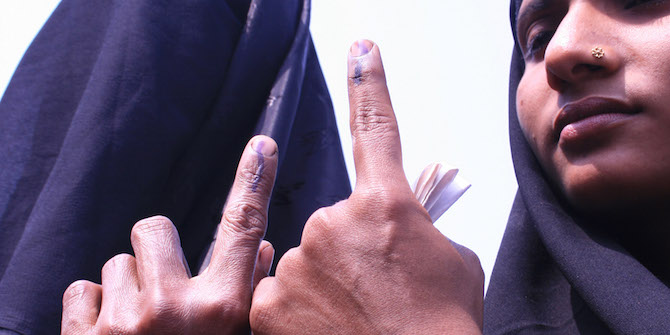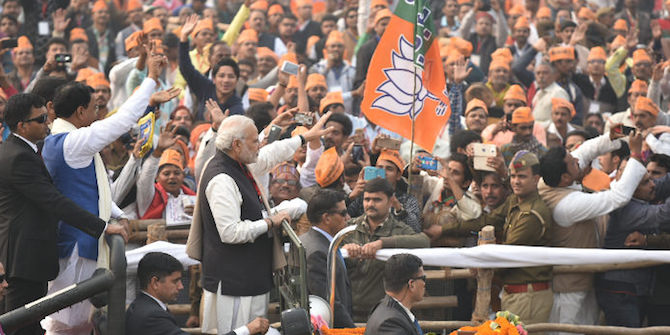In this two-part interview, LSE’s Professor Sumantra Bose puts the regionalisation of the Indian polity in historical perspective.
In Indian state elections whose results were announced in March this year, the Congress party suffered defeats in crucial states, including India’s most populous state Uttar Pradesh, where the party trailed in fourth place. The state-level contests two years ahead of national elections highlighted the growing power of India’s regional parties.
LSE’s Professor Sumantra Bose has researched the growing clout of regional parties for a forthcoming book, Transforming India: The World’s Largest Democracy in the Early 21st Century, which charts the evolution of Indian democracy over the past two decades. Transforming India will be published by Harvard University Press in 2013. In this two-part interview, Professor Bose helps contextualise the end of the era of Congress hegemony and explains why the steady regionalisation of the Indian polity is a historical inevitability.
Q. What explains the regionalisation of Indian politics?
A. A diverse polity is a natural state for India, given how diverse India is as a country. The Indian Union of 28 States is as diverse as the European Union of 28 sovereign nation-states (counting Croatia, due to join in 2013). For 42 years after independence, until the ninth national (Lok Sabha) election of November 1989, India’s was a single-party dominated system. This was because the Congress party had an inherited legitimacy resulting from its three-decade-long leadership of the freedom movement prior to 1947 as well as an organisational head-start on all rivals.
The first time that the Congress faced a threat to its supremacy was in 1967 during the fourth Lok Sabha election. That year, Congress saw its majority in the Lok Sabha (the directly elected ‘House of the People’ of Parliament) significantly reduced—and in state elections it was either defeated or could not form governments on its own in many states. But the Congress was able to re-establish its dominance within a few years because it had one key advantage: the political opposition was highly fragmented.
Notably, the Congress party has never won an absolute majority in any national election: the highest-ever proportion of the popular vote it won was 48 per cent in December 1984, when Rajiv Gandhi benefited from the sympathy vote following the assassination of Indira Gandhi. Even in the first Lok Sabha election in 1952, the majority of the Indian electorate voted for non-Congress parties, giving the Congress only 45 per cent of the popular vote nationwide. Still, the party came to dominate because it benefited from India’s ‘first-past-the-post’ plurality-majority voting system, which disproportionately rewards the frontrunner party.
As such, the regionalisation of the Indian polity is probably a historical inevitability. As early as 1967, regional parties such as the Dravida Munnetra Kazhagam (DMK) in Tamil Nadu were on the rise. In 1983, N.T. Rama Rao’s Telugu Desam Party (TDP) crushed Congress in state elections in Andhra Pradesh. Meanwhile the Left Front, an alliance of left-wing parties and essentially also a regional or state-specific formation, stayed in power in West Bengal for 34 years from 1977 to 2011. But it took the end of the Congress’s nationwide dominance in November 1989 for there to be a fundamental change in the Indian polity.
The trend towards regionalisation is illustrated well by the example of Uttar Pradesh (UP, India’s largest state in population, which has more than 200 million people and 80 out of 543 seats in the Lok Sabha). The Congress was almost continuously in power in UP from independence until 1989. The party’s social base comprised of upper-caste Hindus (accounting for approximately one-fifth of the state’s population), Dalits or the lowest castes (also roughly one-fifth of the state population) and Muslims (more than one-sixth of the population). This was the winning combination.
But in the early 1990s this Congress vote base fell away: most of the upper-caste Hindus defected to the Bharatiya Janata Party (BJP), the Hindu nationalist party; the Dalits moved on a mass scale to the Bahujan Samaj Party (BSP), a party formed in 1984 to provide an autonomous platform and voice to the lowest castes; and most Muslims, upset about the Ayodhya conflict which resulted in the razing of the Babri Mosque in UP in December 1992, transferred their vote to the newly launched Samajwadi Party (SP). The most recent impact of this transformation is evident in the results of the state election in March, when the Congress came in a distant fourth and the BJP, the other party with a ‘national’ identity, finished a poor third. In the early 21st century UP politics is dominated by two regional parties, the SP and the BSP. In UP state elections in both 2007 and 2012 the SP and the BSP won about 56 per cent of the votes cast and three-fourths of the seats in the UP legislature.
Q. What are the pros and cons of the regionalisation of Indian politics?
A. Overall, regionalisation is a positive development as it deepens the representative character of the polity and gives voice and space to numerous social groups in the democratic system. If India’s social map is dazzlingly diverse, why should its political map be any different? But it is still a development with complex implications. The fact is that the most powerful leaders in India’s politics today are regionalists who have a mass base in one populous state of the Indian Union. This extends beyond explicitly regional parties to a ‘national’ party like the BJP. An example is Narendra Modi, the controversial chief minister of Gujarat. He’s a regional satrap even though he belongs to a national party, the BJP. The secret of his success as a politician is that he has managed to present himself as an authentic representative of Gujaratis as a people and Gujarat as a state.
A potential problem with the dominance of regional figures in India’s politics is this: Since these leaders are (legitimately) concerned with their own states, a wider national perspective may get diminished. As in any federal system, there are matters of governance, especially in the realms of economic policy and foreign policy, that have to be addressed at the federal level. We need much greater coordination and consultation between India’s regional leaders so that a national perspective is not lost on these issues.
The other result of regionalisation is that regional parties decide who governs at the ‘Centre’ (New Delhi) as they are absolutely indispensable to the formation of coalition governments. The fact that the regional parties are holding all the cards can lead to problems. Take the example of the 2G scam: Tamil Nadu’s DMK is the regional party directly implicated in this case of high-level corruption. A party leader, A. Raja, was the minister of telecommunications in the Congress-led UPA I coalition government (2004-2009) and it’s quite clear that Prime Minister Manmohan Singh was aware of what he was up to but chose not to intervene. The likely explanation is that Singh didn’t want to rock the UPA boat. The power of regional parties should not mean that corruption goes unchecked.
That said, there are notable examples of corruption-free and reformist regional political leaders. For example Nitish Kumar, the chief minister of Bihar since late 2005, has earned praise for his forward-looking politics and policies.
In the second part of this interview, Professor Bose contextualises the Maoist movement and the Kashmir dispute in light of the regionalisation of Indian politics.
Sumantra Bose is Professor of International and Comparative Politics in LSE’s Department of Government.










Excellent, esp the last paragraph. “The power of regional parties should not mean that corruption goes unchecked.” Hope some sensible politicians [oxymoron?] see this.